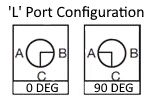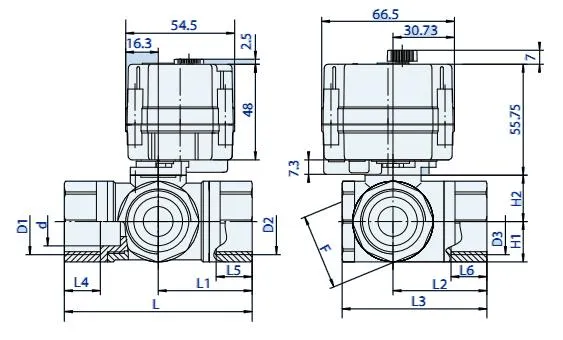Features:
Size 1/2" to 3/4" BSP
Body 316 Stainless Steel
Seat PTFE
Pressure 10 BAR
Temperature 0°C to 90°C
Actuation Capacitor Return Low voltage
The 3 way L port BAS series electrically actuated ball valves automatically returns the valve to its original position when de-energised. The compact design works in the same way as a solenoid valve and can be considered ‘fail safe’ once the storage capacitor has charged up (approx 60 seconds). Unlike a solenoid valve, the 3 way series BAS can take full pressure in either direction, eliminating the need for a check valve. It has a wide range of industry applications namely; dirty or contaminated fluids, viscous fluids, some corrosive fluids (check compatibility), gravity feed applications, anti water hammer slow close function, IP67 corrosive resistant enclosure, low power/solar/battery operated circuits (12-24v AC/DC). Threads conform to ISO 7.1 Sealing Threads.
| Model | Size (BSP) | Size (mm) | Media Pressure | Media Temperature |
|---|---|---|---|---|
| BASM3L4B-EL-T | 1/2" | 12 | 0 to 10 Bar | 2°C to 90°C |
| BASM3L5B-EL-T | 3/4" | 15 | 0 to 10 Bar | 2°C to 90°C |
| Body Material | 316 S.S |
|---|---|
| Ball Material | 316 S.S |
| Seat Material | PTFE with Viton O’Ring |
| Enclosure | Thermoplastic IP65 |
| Current | 5 Watt Max (45 ~ 100 mA) |
| Current Draw at rest (open or close position) | 20 Milli Amp |
| Capacitor Charge Time | 60 Seconds |
| Open/Close Time | 5 Seconds |
| Mounting | Any Attitude |


All dimensions in mm unless shown otherwise.
Size 1/2" to 3/4" BSP
Body 316 Stainless Steel
Seat PTFE
Pressure 10 BAR
Temperature 0°C to 90°C
Actuation Capacitor Return Low voltage
What is a 3 way L Port Auto Return Electric Stainless Steel Ball Valve?
An auto return 3 way L port electric stainless steel ball valve is constructed of 316 Stainless Steel with a direct mounted IP67 capacitor return electric actuator fixed to the valve which conducts its 90 degree turn. Instead of a complete isolation or completely open like a 2 way valve (2 states, closed or open) it will have one line open and one line closed. It is important to note that during its 90 degree turn from one line to another there is a point where all lines are partially open to each other even though this is for a limited period of time. They have teflon (PTFE) seats with FKM seals. The valve is what we call a two wire operation (for instance similar to a solenoid valve) where as long as power has been continuously supplied to the unit for 30 seconds it will close by drawing from the capacitor when the power is removed from the unit (power turned off or power failure). This gives the advantage of a solenoid valve without the disadvantages in situations where the media is dirty and would clog a solenoid valve (although its cycle time is slower).
How does a 3 way L Port Capacitor Return Stainless Steel Ball Valve work?
The ball valve itself works the same as any normal three way ball valve whereby the ball is rotated 90 degrees within the body of the valve which will 'switch' the open port in the valve. The best analogy for this operation is an analogue clock whereby the pressure is in 6 and out 3 or in 6 and out 9. The ball is turned by a capacitor return electric actuator which is connected to a shaft which in turn is mated to the ball by a female slot. The electric actuator needs 30 seconds to charge before the capacitor has enough capacity to close the valve when power is removed. There are only two wires going to the actuator so it effectively has two states; on or off. The unit has a manual override on the top of the actuator to manually operate the valve.
How long will my 3 way L Port Electrically Actuated Auto Return Stainless Steel Ball Valve last?
Like any valve this depends upon the usage case of your ball valve, its environment, media and how many times it is cycled. For instance if it is on a clean media, in a clean environment and not cycled regularly the life will be decades or more. If it is on a corrosive media and in a dry application with a high cycle rate the life will be much shorter.
How do I install a 3 way L Port Capacitor Return Stainless Steel Ball Valve?
Before installation the line must be isolated and pressure removed. The valve itself has female parallel BSP threaded ends so it is best to put a male tapered BSP fitting into the valve ends. Thread tape or a sealant should be used to help the seal and also if dissimilar metals are used it will reduce dissimilar metal corrosion. The electric actuator has only two wires leading to it so effectively only has two states.
What are typical uses of a 3 way L Port Auto Return Stainless Steel ball valve?
These are really used in applications where a solenoid valve would be used but the media does not allow this such as where there are too many suspended solids and would clog the bleed holes in a solenoid valve. Being a 3 way L port valve they are really used for switching applications. Its easiest to visualize this using an analogue clock where the pressure supply port is 6 and it is either out 3 or out 9.
How long will my product take to get to me?
This depends upon where you are based and the freight method chosen. If the express freight option is selected it is usually next day delivery to metropolitan areas in Australia for under 5kg. If free freight has been selected it will go by road freight which can be anywhere from 1 to 10 days depending upon your location. It usually averages 3 days.
What warranty do I get?
All of our products come standard with a 12 month warranty. The good news is we have very strict quality controls and all valves leave our warehouse tested (full material and testing certificates to API598 are available) and inspected so there are rarely any issues. Also once your valve is in and operating it will most likely continue to do so for a very long time.

Size 1/2" to 3/4" BSP
Body 316 Stainless Steel
Seat PTFE
Pressure 10 BAR
Temperature 0°C to 90°C
Actuation Capacitor Return Low voltage

The 3 way L port BAS series electrically actuated ball valves automatically returns the valve to its original position when de-energised. The compact design works in the same way as a solenoid valve and can be considered ‘fail safe’ once the storage capacitor has charged up (approx 60 seconds). Unlike a solenoid valve, the 3 way series BAS can take full pressure in either direction, eliminating the need for a check valve. It has a wide range of industry applications namely; dirty or contaminated fluids, viscous fluids, some corrosive fluids (check compatibility), gravity feed applications, anti water hammer slow close function, IP67 corrosive resistant enclosure, low power/solar/battery operated circuits (12-24v AC/DC). Threads conform to ISO 7.1 Sealing Threads.
| Model | Size (BSP) | Size (mm) | Media Pressure | Media Temperature |
|---|---|---|---|---|
| BASM3L4B-EL-T | 1/2" | 12 | 0 to 10 Bar | 2°C to 90°C |
| BASM3L5B-EL-T | 3/4" | 15 | 0 to 10 Bar | 2°C to 90°C |
| Body Material | 316 S.S |
|---|---|
| Ball Material | 316 S.S |
| Seat Material | PTFE with Viton O’Ring |
| Enclosure | Thermoplastic IP65 |
| Current | 5 Watt Max (45 ~ 100 mA) |
| Current Draw at rest (open or close position) | 20 Milli Amp |
| Capacitor Charge Time | 60 Seconds |
| Open/Close Time | 5 Seconds |
| Mounting | Any Attitude |


All dimensions in mm unless shown otherwise.